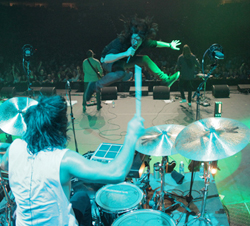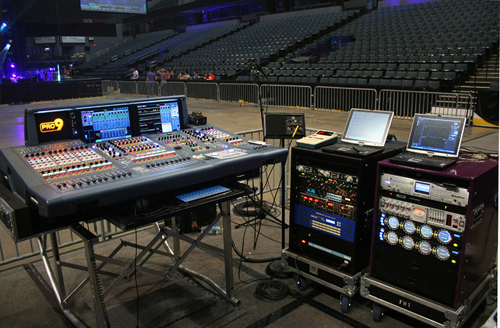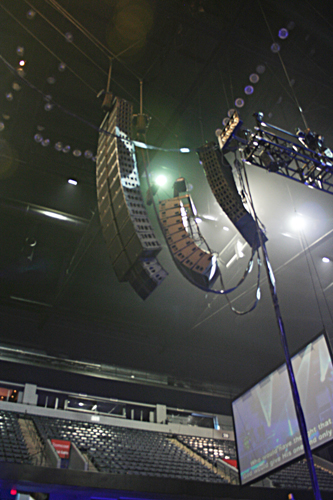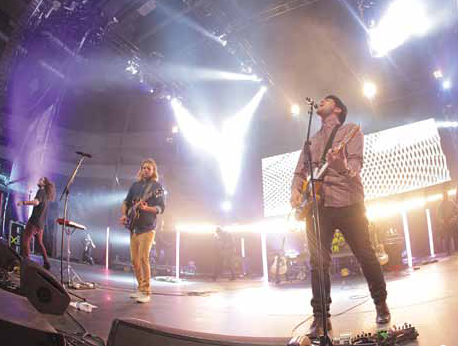
“Another benefit of the K1 is that it is really easy to rig,” adds Pippett. “Our load in and out times are significantly shorter than on previous tours, and I think part of that is the streamlined rigging system of the K1.”
The rack-mounted L-Acoustics LA8 amplifier controllers (4 x 1,000 watts at 4 ohms) drive all main loudspeakers and subwoofers.
The total of 36 LA8 units reside off stage left and right, with the sound team also taking advantage of their network remote control and monitoring capability.
Overall main system processing (delay, limiting, EQ, etc.) is handled via two Lake digital signal processors at front of house.
By the way, at smaller venues the K1 system stays in the truck and KUDO arrays serve as mains.
Going Digital
Rudder is also getting good use of the Midas PRO9 digital console he mans at front of house. Another PRO9 is the choice of monitor engineer Brad Law at his stage left position.
“Once you have worked with different digital consoles, you realize that they all kind of do the same thing – it’s just a matter of figuring out the workspace and you’re good to go,” Rudder notes. “So when I’m choosing one console over another it comes down to the sound, and I really like the sound of the preamps on the PRO9. I also think the dynamics are better than other consoles that we’ve used. Even right out of the box it sounded really, really good.”
The effects package on the PRO9 is enhanced by several outboard devices. An Empirical Labs EL7 FATSO provides parallel compression on the drums, with Lexicon 480L and PCM91 processors as well as a TC Electronic TC2290 for a range of general effects.
Ruder also inserts an Avalon 747 on the back end of the stereo bus for additional presence, and he employs a Rane C4 quad compressor to tame the dynamics on some of the vocals.

The microphone package is simple and effective, with Shure SM57s on all guitar cabinets, with more SM57s on snare drum. The rest of the kit is covered with a Shure Beta 52A and Sennheiser e901 on kick, Sennheiser e904s on toms, and AKG C 414 condensers for overheads. Vocalists are standardized on Sennheiser SKM 935 G3 wireless systems.
Well Equipped
Stage monitoring is a hybrid approach under monitor engineer Law’s direction. Some members of the band are on Sennheiser EW300-IEM G3 wireless systems, while the drummer and bass and keyboard players are outfitted with Shure PSM600 hardwired IEM packs.
L-Acoustics 12XT coaxial wedges adorn the front of the stage, used only for the sermon component of the program. They’re driven by two more LA8 amplifier controllers.
“From the beginning of the signal chain to the end – it all sounds exactly how we want it to,” says Pippett. “And the system provides us with the flexibility we need for the different venues we play at. Although most of our events are in arenas, we still perform at the occasional theater, and in that case we can easily downsize the system to work to those specifications as well.”
These days, though, Hillsong United is more likely to be found selling out arenas than playing smaller venues, but regardless, they’re well equipped.
Remembering their roots and the days of touring from one small church to another, Rudder concludes. “It’s all about providing the best worship experience possible, and we’re just thankful that we can continue to do that wherever we’re playing.”
Julie McLean Clark is a writer and marketing consultant who has worked in the pro audio industry for more than 15 years.


